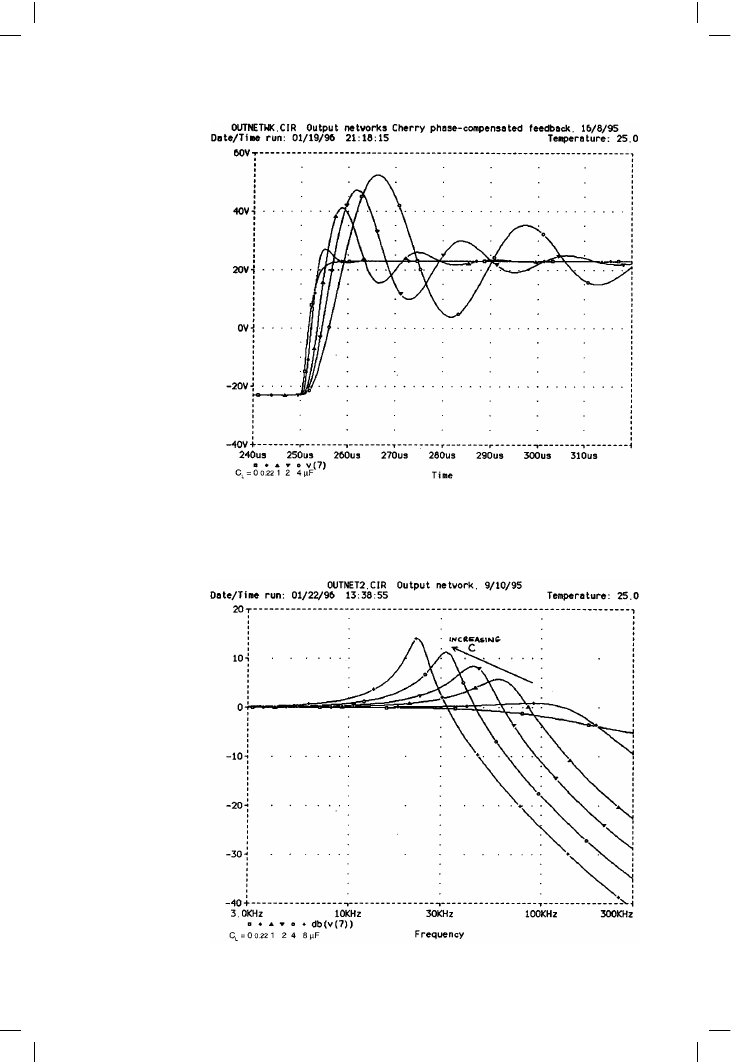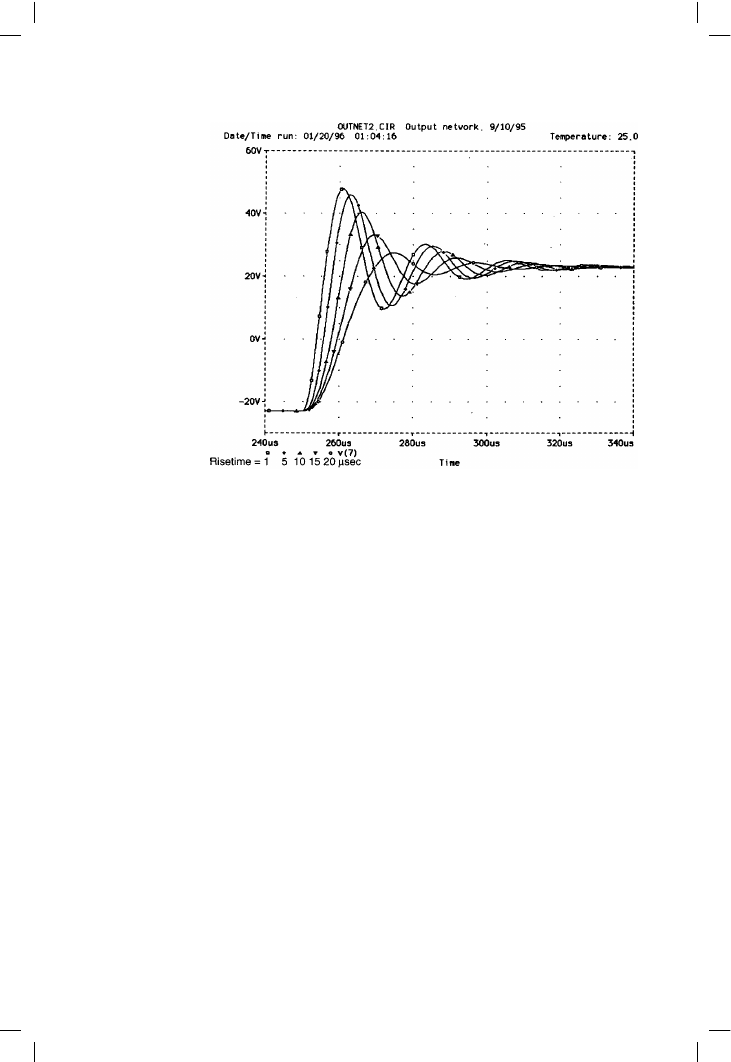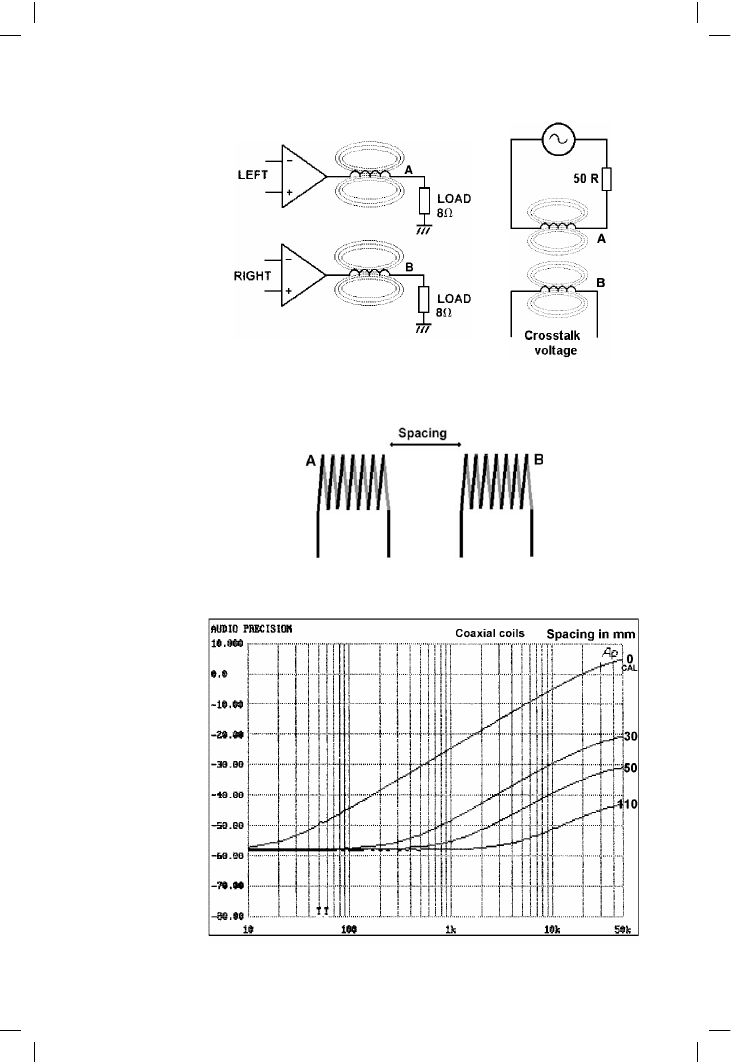ВУЗ: Казахская Национальная Академия Искусств им. Т. Жургенова
Категория: Учебное пособие
Дисциплина: Не указана
Добавлен: 03.02.2019
Просмотров: 17427
Скачиваний: 18

Audio Power Amplifier Design Handbook
200
Figure 7.12
Increasing the load
capacitance
increases the
transient overshoot,
while lowering its
frequency
Figure 7.13
Increasing the load
capacitance
increases frequency
response peaking
and lowers its
frequency

Compensation, slew-rate, and stability
The resistance of an air-cored 7 µH coil made from 20 turns of 1.5 mm
diameter wire (this is quite a substantial component 3 cm in diameter and
6 cm long) is enough to cause a measurable power loss into a 4 ! load, and
to dominate the output impedance as measured at the amplifier terminals.
The coil wire should therefore be as thick as your cost/quality tradeoffs
allow.
The power rating for the damping resistor is assessed as follows. For a
resistive 8 ! load the voltage across the output inductor increases slowly
with frequency, and the damping resistor dissipation only reaches 1.2 mW
at 20 kHz for 1 Vrms output. This assumes a normal 10 ! damping resistor;
if the value is reduced to 1 ! to eliminate ringing into capacitive loads, as
described above, then the dissipation is ten times as great at 12 mW.
A much greater potential dissipation occurs when the load is the traditional
8 !/2 µF combination. The voltage across the output inductor peaks as it
resonates with the load capacitance, and the power dissipated in a 10 !
damping resistor at resonance is 0.6 W for 1 Vrms. This is however at an
ultrasonic frequency (around 50 kHz with a 7 µH inductor) and is a fairly
sharp peak, so there is little chance of musical signals causing high
dissipation in the resistor in normal use. However, as for the Zobel network,
some allowance must be made for sinewave testing and oscillatory faults,
so the damping resistor is commonly rated at between 1 and 5 W. An
ordinary wirewound component works well with no apparent problems
due to self-inductance.
201
Figure 7.14
The most important
factor in transient
response is actually
the rise-time of the
square-wave input,
especially for
overshoot
percentage. The
ringing frequency is
unaffected

Audio Power Amplifier Design Handbook
The output inductor value
As mentioned above, the output inductor for all my designs started out at
20 turns and approx. 6 µH. In later tests the inductor was cut in half, now
measuring 2.3 µH inductance and 10.1 m! DC resistance; this component
was stable for all capacitor values, but has not had rigorous testing with real
loudspeakers. It does now look more like an ‘average’ amplifier inductor,
rather than an oversized one.
An alternative method of stabilisation is a series resistor instead of the
inductor. Even with 100 nF loading, a OR1 wirewound output resistor
completely removed ringing on the amplifier output. This is cheaper, but
obviously less efficient than an inductor, as 100 m! of extra resistance has
been introduced instead of 10 m! with the new 2.3 µH inductor. The
Damping Factor with OR1 cannot exceed 80. A more important objection
is that the 4 ! output power appears to be significantly reduced – a
200 W/4 ! amplifier is reduced to a 190 W unit, which doesn’t look so
good in the specs, even though the reduction in perceived loudness is
negligible.
Cable effects
Looking at the amplifier-cable-load system as a whole, the amplifier and
cable impedances have the following effects with an 8 ! resistive load:
!
A constant amplitude loss due to the cable resistance forming a potential
divider with the 8 ! load. The resistive component from the amplifier
output is usually negligible.
!
A high-frequency roll-off due to the cable inductance forming an LR
lowpass filter with the 8 ! load. The amplifier’s output inductor (to give
stability with capacitative loads) adds directly to this to make up the total
series inductance. The shunt capacitance of any normal speaker cable is
trivially small, and can have no significant effect on frequency response
or anything else.
The main factors in speaker cable selection are therefore series resistance
and inductance. If these parameters are below 100 m! and 3 µH, any
effects will be imperceptible. This can be met by 13 amp mains cable,
especially if all three conductors are used.
If the amplifier is connected to a typical loudspeaker rather than a pure
resistance the further effects are:
!
The frequency response of the voltage at the loudspeaker terminals
shows small humps and dips as the uneven speaker impedance loads
the series combination of amplifier output impedance and cable
resistance.
!
The variable loading affects the amplifier distortion performance. HF
crossover distortion reduces as load resistance increases above 8 !; even
202

Compensation, slew-rate, and stability
68 ! loading increases HF distortion above the unloaded condition. For
heavier loading than 8 !, crossover may continue to increase, but this is
usually masked by the onset of Large Signal Non-linearity
[16]
.
!
Severe dips in impedance may activate the overload protection circuitry
unexpectedly. Signal amplitudes are higher at LF so impedance dips here
are potentially more likely to draw enough current to trigger protection.
Crosstalk in amplifier output inductors
When designing a stereo power amplifier, the issue of interchannel
crosstalk is always a concern. Now that amplifiers with up to seven
channels for home theatre are becoming more common, the crosstalk issue
is that much more important, if only because the channels are likely to be
more closely packed. Here I deal with one aspect of it. Almost all power
amplifiers have output coils to stabilise them against capacitative reac-
tances, and a question often raised is whether inductive coupling between
the two is likely to degrade crosstalk. It is sometimes suggested that the
coils – which are usually in solenoid form, with length and diameter of the
same order – should be mounted with their axes at right angles rather than
parallel, to minimise coupling. But does this really work?
I think I’m pretty safe in saying there is no published work on this, so it was
time to make some. The coil coupling could no doubt be calculated
(though not by me) but as often in the glorious pursuit of electronics, it was
quicker to measure it.
The coils I used were both of 14 turn of 1 mm diameter copper wire, overall
length 22 mm and diameter 20 mm. This has an inductance of about 2 µH,
and is pretty much an ‘average’ output coil, suitable for stabilising
amplifiers up to about 150 W/8 !. Different coils will give somewhat
different results, but extrapolation to whatever component you are using
should be straightforward; for example, twice the turns on both coils means
four times the coupling.
Figure 7.15 shows the situation in a stereo power amplifier. The field
radiated due to the current in Coil A is picked up by Coil B and a crosstalk
voltage added to the output signal at B.
Figure 7.16 shows the experimental setup. Coil A is driven from a signal
generator with a source impedance of 50 !, set to 5 V rms. Virtually all of
this is dropped across the source resistance, so Coil A is effectively driven
with a constant current of 100 mA rms.
Figure 7.17 shows the first result, taken with the coils coaxial and the ends
touching. (This proved, as expected, to be the worst case for coupling.) The
crosstalk rises at 6 dB/octave, because the voltage induced in Coil B is
proportional to the rate of change of flux, and the magnitude of peak flux
is fixed. This is clearly not the same as conventional transformer action,
203

Audio Power Amplifier Design Handbook
204
Figure 7.15
(a) The coupling of
output coils in a stereo
power amplifier.
(b) The experimental
circuit. The
‘transmitting’ Coil A is
driven with an
effectively constant
current, and the
voltage across the
‘receiving’ Coil B
measured
(a)
(b)
Figure 7.16
The physical coil
configuration for the
measurement of
coaxial coils
Figure 7.17
Crosstalk vs spacing
for coaxial coils